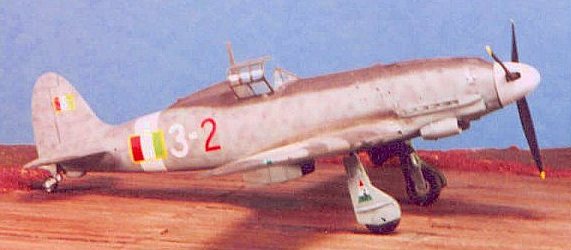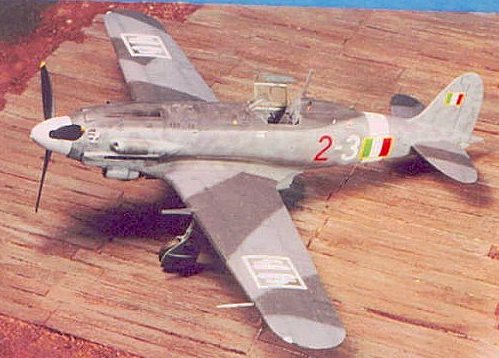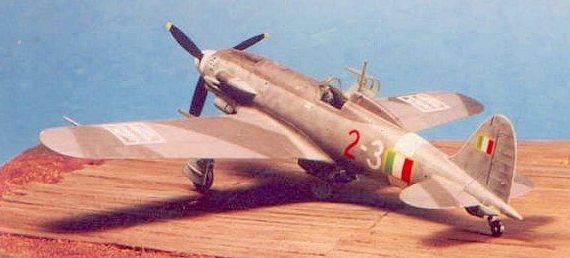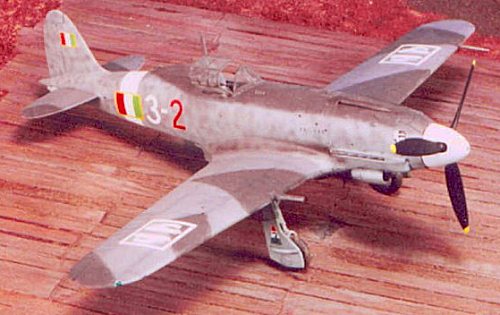
Hasegawa Macchi C.205V 'Veltro'
|
KIT # |
9133 |
|
PRICE: |
$29.98 |
|
DECALS: |
See review |
|
REVIEW:: |
|
|
NOTES: |
Aeromaster 48-190 decals used. |

|
HISTORY |
The series of fighters designed by Mario Castoldi and produced by Aer Macchi shared with the British Spitfire an ancestry in the Schneider Cup Trophy Racers, Castoldi's M.C.72 having been the only serious contender to the Supermarine S.6B, had it been ready in time for the 1931 competition. The aircraft went on to better the S.6B's air speed record the following year.
The first of the fighter series, the C.200 "Saetta," certainly looked nothing like a Schneider Cup racer, with the bulky and underpowered Fiat R.C.40 radial hanging on a hump-backed fuselage with an open cockpit that was the result of conservative Italian fighter pilots' insistence on maximum visibility over speed. Even so, the airplane was superbly maneuverable, with finger-light controls.
 In 1940, Castoldi was
able to lay hands on the German Daimler-Benz engine, and with the next of the
series, the C.202 "Folgore," the Schneider lines returned, the
DB-601-powered "Folgore" being one of the most aesthetically-pleasing
fighters to fly during the war. In late 1941, the higher-powered DB605 with
1,475 h.p. became available. Castoldi's next generation of fighter was created
in two steps: the C.205V which was a minimally-modified C-202 airframe adopted
for the new engine, and the C.205N, which had increased length and wingspan and
was fully designed to take advantage of the increased power.
In 1940, Castoldi was
able to lay hands on the German Daimler-Benz engine, and with the next of the
series, the C.202 "Folgore," the Schneider lines returned, the
DB-601-powered "Folgore" being one of the most aesthetically-pleasing
fighters to fly during the war. In late 1941, the higher-powered DB605 with
1,475 h.p. became available. Castoldi's next generation of fighter was created
in two steps: the C.205V which was a minimally-modified C-202 airframe adopted
for the new engine, and the C.205N, which had increased length and wingspan and
was fully designed to take advantage of the increased power.
The C.205V, named the "Veltro," first flew April 19, 1942. The prototype was in fact a "Folgore" airframe with some local strengthening. While the Serie I and II "Veltro" had the same armament as the late-series "Folgore" - two 12.7mm and two 7.62mm machine guns - the Serie III "Veltro" that was destined to be the most-produced version dropped the light wing guns in favor of two 20mm MG151 cannon with 250 r.p.g. If anything, the "Veltro" was even more aerodynamically beautiful than its predecessor.
The C.205 Serie III "Veltro" had a top speed of 399 m.p.h. at 23,620 ft., an altitude it could attain in 7 minutes, 6 seconds. The fighter bore comparison with the best Allied fighters extant, and would be one of the few Axis aircraft capable of matching the P-51B and D Mustangs - which it would fight in a series of spectacular air battles over Northern Italy in June and July 1944 when the Mustangs first began escorting the B-17s and B-24s of the 15th Air Force on their missions into Austria and Hungary.
Interestingly enough, the
C.205N "Orione" - the version designed specifically for the DB605
powerplant - turned out to have inferior performance to the "slapped-together"
variant, being some 2-3 m.p.h. slower than the C.205V at all altitudes. Given
that the C.205V could be introduced to production with a minimum of disruption
to the line, while the C.205N would require all-new jigs and tooling, the
earlier version was confirmed as the production model.
The C.205V first entered combat during the Battle of Pantelleria on July 8, 1943, escorting S.M.79 torpedo bombers and C.200 "Saetta" fighter-bombers attacking the allied warships shelling the island. Eight "Veltros" from the 3rd Stormo and ten from the 51st Stormo were among the fighters available for the defense of Sicily when the island was invaded on July 9, 1943; they were quickly overwhelmed by the Allied air forces supporting the invasion.
When Italy surrendered on September 8, 1943, six "Veltros" were among the aircraft that flew south to become part of the Co-Belligerent Air Force. The other sixty on charge with the Regia Aeronautica remained in the north, where they equipped the 1st and 2nd Gruppi Cacci of the Repubblica Sociale Italiana. By the Spring of 1944, these aircraft and the Fiat G.55s that equipped the 3rd Gruppo Caccia were the entire Axis fighter force opposing the incursions of the new 15th Air Force which was to carry the strategic war from Italy to the southern regions of the Third Reich. By the Fall of 1944, the three Gruppi Cacci were a spent force; when it was rumored that they would be impressed into the Luftwaffe, the Italian pilots burned their aircraft rather than follow that order. The surviving "Veltro's" were replaced with Messerschmitt Bf-109s for the rest of the war.
Today, a single C.205V Veltro exists. It was restored to flying condition by Aer Macchi in the 1980s.
|
THE KIT |
Hasegawa released the C.205V "Veltro" in late 1994, following the release of the C.202 "Folgore." Both of these kits were among the first Hasegawa kits to provide an accurately detailed cockpit. Jaguar provided an aftermarket resin cockpit for the C.202 that can be used for the C.205V (many of which were re-engined C.202s), but to tell you the truth I think if you have a set of seatbelts to use for the kit cockpit that the end result is not that much better for the additional cost.
|
CONSTRUCTION |
These kits are among the best-engineered kits Hasegawa has ever released. The C.205V as close to a "fall together" kit as you can come up with, only needing a bit of Mr. Surfacer along the centerline seam to result in an outstanding model. Assembly is so easy that the kit is easily a "weekend project."
|
PAINT & DECALS |
Painting: 
Some of the C.205Vs that served with the Aviazione della R.S.I. were repainted with Luftwaffe paints in a "German" style, mostly to differentiate them from the aircraft flown by the Co-Belligerent Air Force, which retained their standard Regia Aeronautica camouflage patterns. I decided to do one of these aircraft, to visually differentiate it from the other models in my Italian collection.
After "pre-shading" the model with flat black along the panel lines, I used Gunze Sanyo H-417 "RLM76" Blaugrau, H-68 "RLM74" Graugrun, and H-75 "Dark Sea Grey" for the RLM75 Grauviolett. The scheme was free-handed, with each color being "faded" after application by putting a few drops of Flat White in and going over various panels.
 Decals:
Decals:
I used the Aeromaster Folgore sheet to do this "Veltro" of 2nd Gruppo Cacchia "Asso di Bastoni," serving operationally in the summer of 1944. This sheet comes from when Aeromaster decals were printed by MicroScale, and everything went down with no trouble under a light coat of Micro-Sol.
Final Finish:
Since this airplane had been freshly painted, there was not much weathering. I created the exhaust stains with Tamiya "Smoke," gave the model a final coat of Future, then used two coats of thinned Dullcote for the final finish. I painted the wingtip navigation lights with Gunze-Sanyo Clear Red and Clear Green respectively, attached the canopy and landing gear, and the model was complete.
|
CONCLUSIONS |
This is a well-designed, well-produced kit that goes together with a minimum of hassle and results in a good looking model. Anyone from a virtual beginner to an expert can have fun with it, lavishing as much effort as you want, with a result you can be proud of.
Kit and decals courtesy my wallet.
If you would like your product reviewed fairly and fairly quickly, please contact the editor or see other details in the Note to Contributors.
Back to Reviews Page 2016